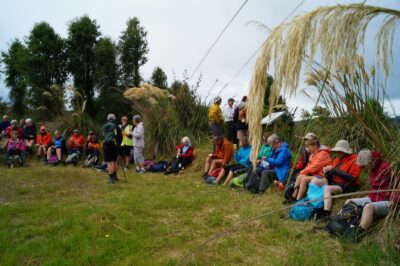11/12/2024. Takitakitoa, Wetland, Waihola Hall. Grade 2. Combined hike and Christmas Lunch. Leaders: Jan Butcher, Wendy Langley, John Gardiner, Graeme Souter.
 This, our final event of 2024, promised to be a fitting farewell to the year’s activities, and a prelude to the Christmas cheer that awaited us all. About 50 keen hikers and trampers assembled at Peter Johnson Park.
This, our final event of 2024, promised to be a fitting farewell to the year’s activities, and a prelude to the Christmas cheer that awaited us all. About 50 keen hikers and trampers assembled at Peter Johnson Park.
Here the Mosgiel Foodbank and lunch food contributions (bring a plate) were collected into Barbara and Jenni’s cars for transport directly to the Waihola hall. After welcoming a few “south of Mosgiel” members at our starting point, 55 of us set off.
With mild, overcast, almost windless conditions initially, the day’s weather looked promising, and far removed from the lunch time rain showers forecast. The car journey to Takitakitoa wetlands was uneventful (for once) with no-one getting lost along the way. Well done Wendy for your very clear “school car rally” style instructions.
Researching the meaning of Takitakitoa revealed what a complex language te reo Maori is. Like English, many words have more than one meaning, and can often be used as nouns, verbs, or in some cases even adjectives. The results of my labours, which could be entirely wrong, were that “Takitaki” as a noun means – fence, palisading, screen, barricade, stockade or picket fence. “Toa” had fewer options, meaning – shop or store. So “potentially” Takitakitoa could be loosely translated to mean a barricade or screen that contains (holds) a store (a supply of value eg food).
Anyway, Takitakitoa wetland is controlled by Fish and Game. Ian, from Fish and Game, met us at the gate, and along with his colleague Jamie, walked with us from our cars to the lookout.

This section of our hike/tramp had undergone a comparatively recent, dramatic transformation with the felling of the pine forest. (Nothing to see but slash here). Rounding a bend, we caught our first glimpse of the wetland, with a flock of wading birds (Spur-winged Plovers) feeding. As if a switch had been thrown, seconds later this tranquil scene was transformed. First a low flying domestic jet’s engine noise could be heard (or was it?) Then the few remaining pine trees opposite began to sway violently, the Spur-winged Plovers took flight and the wetlands surface rippled as a southerly squall hit with a vengeance.
Woken from our melancholy calm, we quickly made our way up through the shelter of the forest to the lookout. Still exposed to the southerly, here coats were donned, before Ian gave us an overview of the wetland. Almost as quickly as it came the southerly squall thankfully abated as we made our way towards the bund.


On the way we stopped at a sheltered spot for morning tea where Ian and Jamie showed us large photos showcasing the wetlands development.

Apparently, with the seemingly minor change of adding the bund (a dam like structure) to re-flood the area, plant and subsequent wildlife development of the area was “self-created”. Remnants of the wetlands original grasses etc. quickly gained the evolutionary upper hand in the newly created environment. Wendy thanked Ian and Jamie on behalf of all, and they left us at this point.


We continued around the edge of the wetland, in ever improving conditions until we reached the bund.


Fortunately, as Ian explained, the geology of the area, with it’s deep, heavy water sealing pug like clay material enabled the creation of a strong and water-resistant bund, built entirely from on-site natural materials. This is not to underestimate the digger driver’s nightmare the soft top layer presented!
We soon found ourselves back at the cars by 12.00 noon. From here it was on to the Waihola hall. A new venue for our club, the hall proved ideal in accommodating us, and thanks to the efforts of Barbara and her team, trestles containing our potluck lunch greeted us, along with a green cabinet displaying the generous donations to the Mosgiel Foodbank made by our members.

By now our numbers had grown with the addition of some of our older members, who did not attend the Takitakitoa visit. After first observing Ian Fleming’s Grace we began our lunch.

Between courses, initially Neil, (a man of many hats), and then Grant, entertained us, before Maria accompanied Grant on guitar for a sing-a long of Christmas Carols. Then it was time for dessert.



By about 2.15 pm people had begun to disperse having enjoyed a well organised, varied, interesting and thoroughly entertaining day out. At true team effort that ensured our members carried the spirit of Christmas home with them.
Merry Christmas
John
P.S. The value of wetlands is often underestimated. Wetland areas have environmental benefits in improving water quality, flood control, and providing wildlife habitat. They have historical significance, particularly to early Maori. International and economic significance (as per the Ramsar Convention report of 2013) as well as educational and recreational value. For more information, including an interesting video
https:wwwfishandgame.org.nz/game-bird-hunting-in-new-zealand/where-to-hunt/regional-info/otago/takitakitoa-wetland/
https:www.southroads.co.nz/projects/Takitakitoa-wetland-restoration-project
From Wendy Langley
Link to background information and earlier tramps and hikes in the same area.


